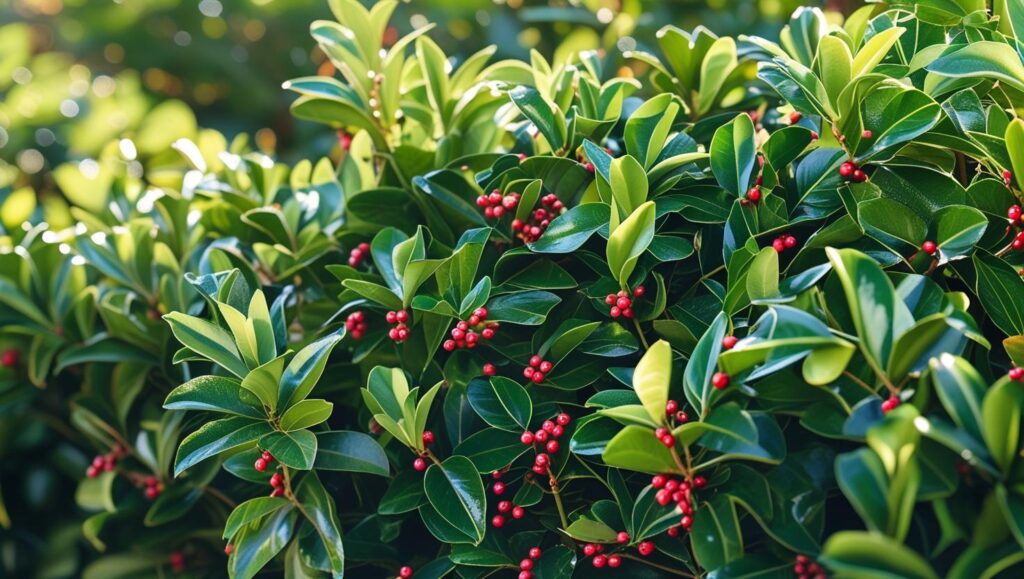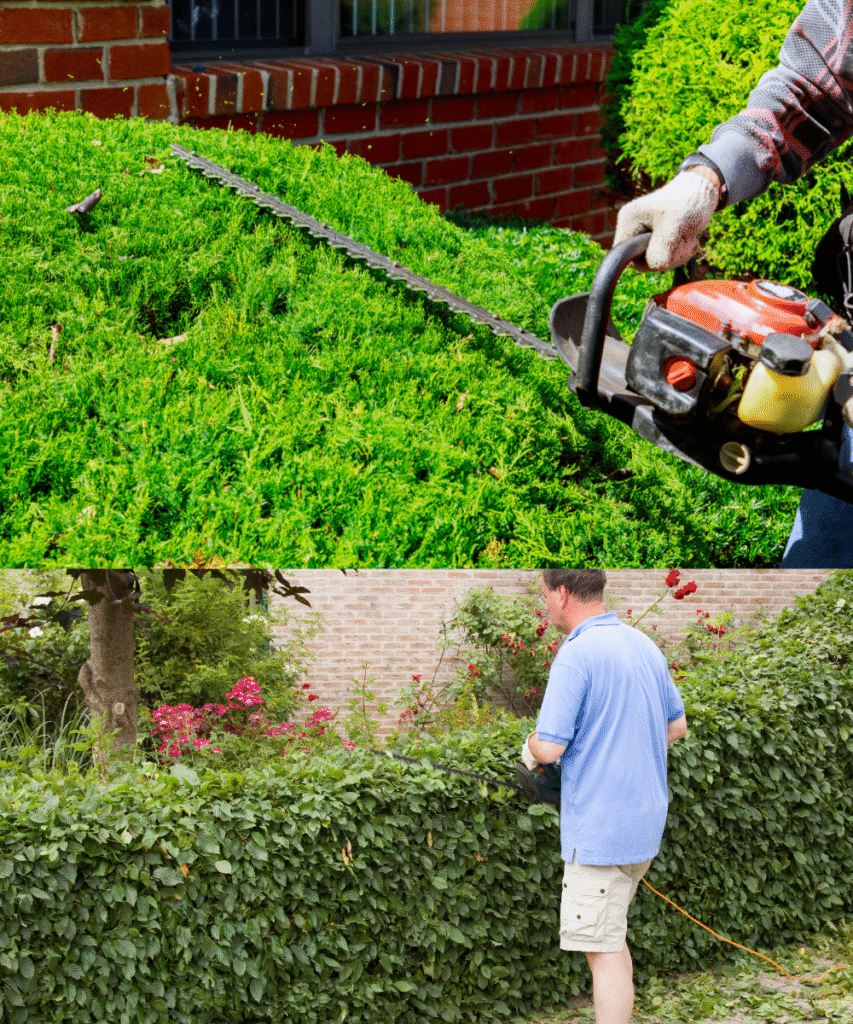Lilly Pilly hedges
Lilly Pilly hedges are a top choice for Australian gardens in 2025. These popular natives belong to the genera Syzygium, Waterhousea, and Acmena (now mostly classified under Syzygium).
Why are they so beloved?
- Fast-growing,
- Low-maintenance
- Have an attractive look
- Dense evergreen foliage
- Colourful and edible berries that attract birds.
Whether you want a privacy screen, a sculpted topiary, or a wildlife-friendly feature, Lilly Pillies fit the bill. They thrive in Australian conditions, from sunny coastal yards to shaded courtyards. Sublime Acmena variety, a favorite among landscapers and home gardeners.

Why Choose Lilly Pilly Trees for Your Hedge?
Lilly Pilly trees are more than just attractive hedging plants—they’re a top choice for Australian gardens in 2025, and for good reason. Here’s why they’re so widely loved and planted:
🚀 Fast Growth
Need quick privacy or a fast screen for your garden? Lilly Pillies grow rapidly, often reaching maturity within a couple of years. This makes them ideal for new builds or rejuvenating an old garden.
🌿 Dense Foliage
One of the standout features of Lilly Pillies is their lush, thick foliage. It forms a natural wall that blocks out noise and neighbours, perfect for suburban living.
🌺 Attractive Appearance
From glossy green leaves to colourful new growth and fluffy white to pink flowers, Lilly Pillies are visually stunning year-round. Many also produce vibrant berries, adding even more seasonal charm.
🛡️ Pest & Disease Resistance
Lilly Pillies are hardy and generally low-maintenance. Some varieties, like Straight and Narrow Syzygium and Hot Flush, are specifically bred to resist common issues like psyllids. Choosing resistant cultivars means less stress and healthier hedges.
🧱 Adaptability
Got clay, sandy, or loamy soil? No problem. Lilly Pillies thrive in most Australian soils and adapt well to local climates. From sunny Brisbane balconies to frosty Melbourne suburbs, there’s a suitable variety.
🐦 Wildlife Friendly
Their berries and flowers attract birds, bees, and butterflies—so you’re not just planting a hedge, you’re creating habitat. Plus, their dense structure offers shelter for small native animals.
🎨 Variety of Options
Whether you want a tight formal hedge, a tall privacy screen, or a low-maintenance pot plant, there’s a Lilly Pilly for it. Columnar types, such as Pinnacle Syzygium or Straight and Narrow, are great for tight spots.
🍃 Evergreen Beauty
Being evergreen, Lilly Pillies remain lush and vibrant throughout the year, providing reliable screening and greenery in every season.
🌦️ Resilience in Harsh Conditions
From scorching summer heat to coastal winds and light frost, Lilly Pillies are tough. They bounce back after tough weather and remain reliable through droughts.
🤧 Low Allergenic
Many Lilly Pilly varieties are low-allergenic, making them a safe choice for families with allergies.
🍇 Edible Berries
Yes, you can eat the berries! Some varieties produce tart, cranberry-like fruit used in jams and cordials. Note: Berries can be messy, so consider opting for low-fruiting types if you prefer a tidier hedge.
Soil Amendments for Clay & Sandy Soils
- Clay soils: Top-dress gypsum (e.g., 200 g/m² weekly) for months to improve structure.
- Combine: Mix in compost or aged manure at the time of planting.
- Raised bed tips: Add drainage mix and gypsum before planting.
- Sandy sites: Apply organic matter, seaweed solution, and light irrigation to promote moisture retention.
Rejuvenation Pruning & Pest Control
- Annual rejuvenation cuts in late winter to restore neglected hedges.
- Use neem oil or eco-friendly insecticides for psyllids on new growth.
- Apply native slow-release fert in spring/summer; Seasol monthly during stress periods.

Design & Styling Playbook: Garden Integration
- Formal vs informal hedging: Formal = Sublime™ or Pinnacle™ trimmed; informal = Resilience or Select shaped naturally.
- Native companion planting: Pair with Lomandra, Dianella, Callistemon, Kangaroo Paw for texture/color.
- Poolside screens: Use deep-rooted types, such as Select, with a root barrier to prevent pavement upheaval.
- Coastal/bushfire landscapes: Fire-resistant Red Head™ and Sublime™, combined with Banksia and Correa, create resilience and aesthetic appeal.

🍇 Edible Berries Deep Dive
Harvest Guidelines & Foraging Calendar
- The best time to pick is later (~February), when the berries are deep red or purple.
- How to forage: Gently twist ripe berries to avoid damaging branches; rinse before use.
Recipes & Health Benefits
- Lilly Pilly Jam: Mix berries, equal parts sugar and lemon juice; simmer until thick.
- Berry cordial: Steep berries overnight in sugar water, then strain.
- Nutritional note: High in antioxidants and vitamin C—great native superfood!
🌏 Localisation: Regional Advice for Aussie Zones
- Brisbane / Coastal QLD: Use Coastal-tolerant Red Head™, Sublime™; mulching is critical in heat.
- Melbourne, VIC: Try Frost-Tolerant Hot Flush™, apply late-autumn mulch, and prune in spring.
- Adelaide / SA: Mediterranean: Plant autumn, water deeply, and choose Resilience and Big Red.
- Perth / WA: Spot in sun/part shade, pick disease-resistant types, add gypsum to clay soils.
- Tasmania / cooler zones: Choose frost-rated varieties like Hot Flush™; protect young plants
How to Plant a Lilly Pilly Hedge (Step-by-Step)
1. Choose the Right Spot
- Sunlight: Full sun to part shade
- Soil: Well-draining and rich in compost
- Spacing: 50cm to 1m apart (depending on the variety)
Use reflective surfaces or mirrors behind the hedge to bounce light onto the foliage—especially helpful in narrow, shaded spaces.
2. Prepare and Soak the Roots
- Soak container-grown plants in water for 30 minutes before planting. This helps the roots absorb water and reduces the risk of transplant shock.
- Dig a hole twice as wide as the root ball.
- Mix in compost and a slow-release native fertiliser.
3. Plant, Water & Mulch
- Backfill gently, water thoroughly.
- Mulch around the base in a shallow “mulch dish” shape—this keeps moisture focused near the roots and avoids rot around the stem.
4. Support Early Growth
- Water regularly during the first 3–6 months.
- Lightly prune to promote bushiness and shape.

Pruning & Maintenance Tips
A beautiful Lilly Pilly hedge thrives with regular care:
- Prune every 2–3 months in warmer seasons to encourage density.
- Trim lightly after each flush of growth for a full, formal hedge.
- Remove suckers and any dead or damaged wood.
- Keep the base of the hedge clear to maintain airflow.
🌟 Topiary goal? Choose compact cultivars like Sublime™ or Hobbit™ for neat, sculpted designs.

🌧️ Watering & Fertilising Guide
- Water: 1–2 times per week during dry spells
- Fertiliser: Use a slow-release native mix in spring and summer
- Mulching: Refresh mulch annually in a bowl shape ~30 cm wide, keeping it 5 cm away from the trunk
🧪 Fact: Lilly Pillies are light feeders but flourish with balanced nutrients and consistent watering.
🐛 Lilly Pilly Hedge Problems & Easy Fixes
Despite their toughness, here are common issues and their simple fixes:
🍇 Are Lilly Pilly Berries Edible?
Yes! Many Lilly Pilly species produce tart red or purple berries in summer. While slightly sour, they are completely edible and can be made into:
- Jam or jelly
- Cordials
- Sauces
- Wildlife snacks
🧑🍳 Try this: Combine Lilly Pilly berries with lemon and sugar to create a tangy native jelly.
🏠 Best Landscaping Uses for Lilly Pilly
- Privacy hedges or windbreaks
- Poolside screens or courtyard borders
- Balcony hedging in pots (use dwarf types)
- Bird and bee habitats
- Firewise planting for bushfire-prone zones (Sublime™, Red Head™)
- Urban gardens need fast cover and minimal care
📍 Best Regions in Australia for Growing Lilly Pilly
Thrives across most Aussie climates, including:
- NSW Coast (Sydney, Wollongong, Newcastle)
- QLD (Brisbane, Sunshine Coast, Gold Coast)
- VIC (Melbourne – in the sun)
- SA (Adelaide – with irrigation)
- WA (Perth, Fremantle, coastal areas)
- TAS (choose frost-hardy types)
🌿 Tip: Choose frost-tolerant cultivars for inland and cool climates.
Advanced Care Masterclass: Filling the Gaps
Myrtle Rust: Identification & 4-Step Treatment Protocol
Identify early: Look for yellow/orange powdery pustules on new shoots or leaves uq.edu.au+3business.qld.gov.au+3en.wikipedia.org+3.
Apply fungicides: Use approved treatments (e.g., mancozeb + miticide/trifend) on calm, dry days, targeting the underside of leaves.
Hygiene & removal: Bag infected debris securely, avoid mulching with it, and clean tools thoroughly. For more information, visit agriculture.vic.gov.au and 1ausbonsai.com.au.
Innovative cure option: RNA-spray technology from UQ shows potential for post-infection recovery at ausbonsai.com.au and +1uq. edu.au
Faqs
Frequently asked questions
Is Eremophila nivea hard to grow?
No! Choose the right spot — full sun and free-draining soil — and it’s low-maintenance.
Can I grow Eremophila nivea in humidity?
Yes, but use a grafted variety for better resistance to fungal issues.
What’s the difference between grafted and own-root Eremophila nivea?
Grafted types thrive in humid or wet areas; own-rooted varieties suit dry inland climates.
Can I grow it in a pot?
Absolutely. Use a native potting mix and ensure excellent drainage.
Why are my Eremophila nivea leaves yellow?
Likely due to overwatering or poor soil drainage—adjust accordingly.
Where can I buy artificial Eremophila nivea in Australia?
Many online native décor retailers now offer realistic, UV-resistant faux options.
Is artificial Eremophila nivea a good choice for indoors?
Yes — it’s perfect for indoor styling, needs no care, and offers year-round beauty.
🌟 Final Thoughts:
Why Lilly Pilly Is Australia’s Favourite Hedge in 2025
If you’re after a fast-growing, evergreen, wildlife-friendly, and easy-to-prune hedge, Lilly Pilly is the answer. Whether you want to screen a fence, boost curb appeal, or create a safe backyard, there’s a perfect cultivar waiting for your garden.
🛒 Visit your local nursery or Aussie online plant shop today and bring home the Lilly Pilly hedge that suits your space and climate!




